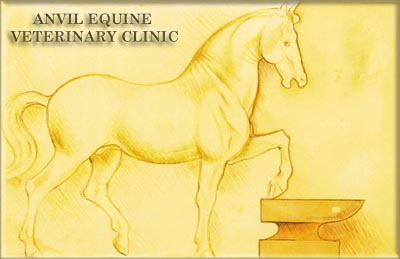
STRANGLES
General Facts
The cause of "Strangles" is
a bacterium called "Streptococcus equi", which
is a wide spread disease of horses and donkeys, but is also
found in a few horses not showing symptoms. All ages of horses
can be infected by the disease which is commonest and most severe
in young horses. The spread of the disease is usually horse
to horse contact via nasal or abscess discharge, but can also
be spread by discharge carried on clothing or inside lorries
etc. The bacterium needs a moist environment to survive, so
clothing and the environment do not act as sources for very
long, unless they remain wet. Once established, this disease
is often highly contagious.
The disease has an affinity for lymph tissue (e.g. tonsils
and lymph nodes), but can also affect other structures, like
joints when it is known as "Bastard Strangles".
Usually symptoms involve a combination of the following signs
after an incubation of 3-14 days of exposure.
-
High temperature (normal is 100.5 - can be
as high as 106)
-
Depression, loss of appetite, difficulty swallowing,
bad breath
-
Swollen jaw and head, extension of the head
and neck. Hard, painful lump under the middle of the jaw or
below the ears. Reddened inside eyelid (conjunctivae).
-
Nasal discharge - often very thick, profuse
and custard-like.
-
Coughing and/or "strangled" sound
to respiration (this is the origin of the name"strangles",
because in a few cases abscesses develop at the throat which
can cut off the flow of air to the lungs by obstructing the
larynx). As they develop abscesses usually ripen and burst
in 7-14 days, often under the jaw, but also inside the throat.
The discharge which bursts out is highly contagious. Symptoms
may last from less than a week to over 2 months, but usually
subside after 2 weeks. Some horses may relapse after a period
of apparent recovery.
Complications
Unfortunately complications that arise from Strangles are
not uncommon.
"Bastard strangles" is defined as any spread
to joints, brain, lungs muscle, chest and abdomen or any area
away from the lymph nodes of the head. If it does establish
in one of these places in the body, the chances of a good
outcome are greatly reduced.
"Purpura" (purpura haemorrhagica) - extreme
depression with severe filling of the legs and head. Pin-prick
bleeding onto the tongue and other mucous membranes is seen.
Survival is as low as 50%.
"Anaemia" (autoimmune haemolytic anaemia)
- this only rarely complicates strangles, and produces a very
depressed horse with rapid self-destruction of red blood corpuscles
- often will develop swollen skin at the base of the abdomen
and filled legs. Usually a second high fever develops some
time after the initial Strangles infection.
"Roaring" (left laryngeal paralysis) -
may result from pressure caused to the nerves supplying the
larynx. These horses make a 'noise' at exercise - it is generally
permanent.
Treatment
This is carried out by your vet, but may include
investigating the bacterium to prove its identity as Strep Equi.
The use of antibiotics such as penicillin may be considered
and also drugs to lower high temperatures. Once abscesses burst
they can be flushed with very diluted disinfectant solutions,
if they are readily accessible e.g. below the jaw. Soft food
may encourage a horse to swallow with more ease.PreventionThe
control of spread can be difficult because by the time a horse
develops the full set of symptoms it may have spread to other
horses in the same yard by mild nasal discharge or coughing.
Careful isolation of affected cases should involve:
-
Separate tack, grooming kit, feet, buckets
and stabling.
-
Overalls worn inside the infected stable
and taken off when you leave.
-
Disinfectant placed at the door for washing
feet and hands when you leave the box.
-
Feeding the infected horses last, so you
do not go to another horse after them.
-
Burning contaminated bedding and disinfecting
boxes one a horse vacates it.
-
Horses may be swabbed to check for residual
infection, but a negative swab does not prove the horse
is clear.
The use of antibiotics in unaffected contact horses may be
considered by your vet.
Immunity
A vaccine is available abroad, but not in the UK. 70% of
infected horses develop a solid, enduring immunity, but it
may take 6-8 weeks to develop after clinical signs first appear.
Infected horses may shed the bacterium in their nasal discharges
for 3-4 weeks after the disease starts. If the pasture has
been grazed by infected horses, it may be prudent to rest
if for a month before being grazed again.
Anvil Vets:
|
|
